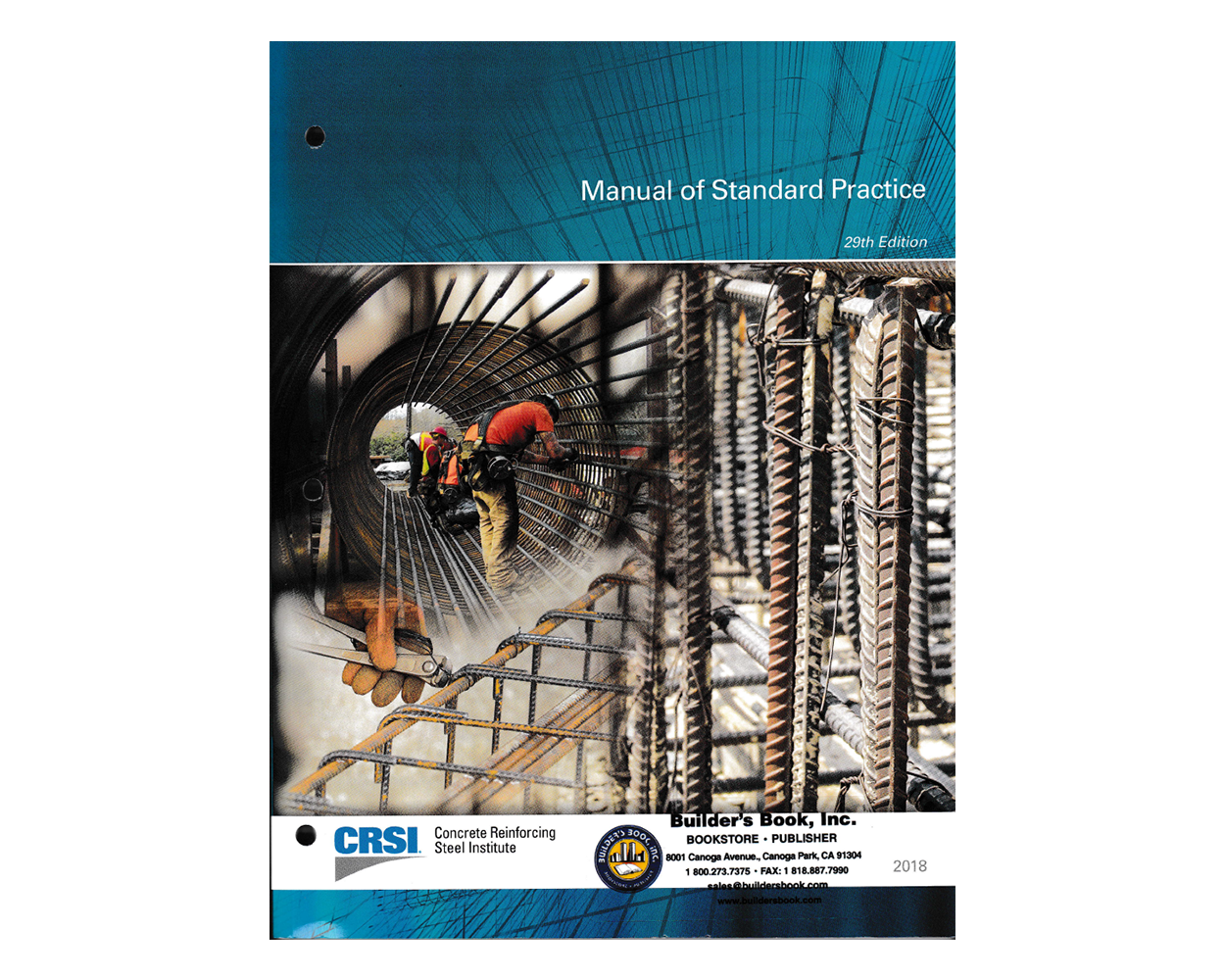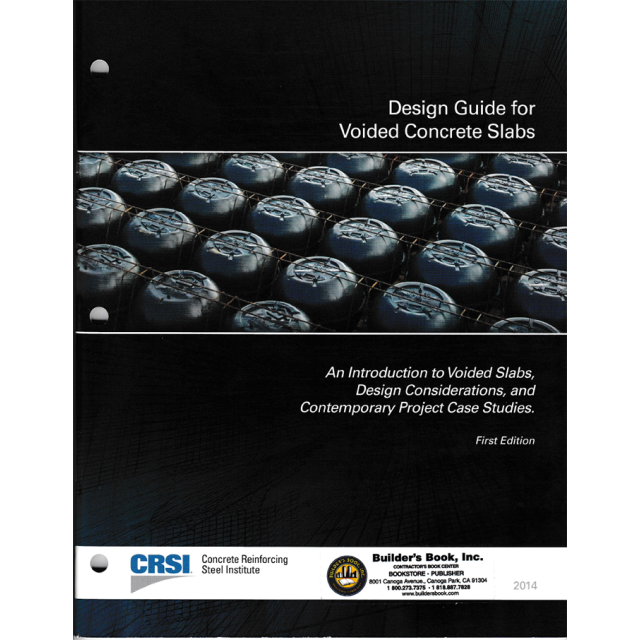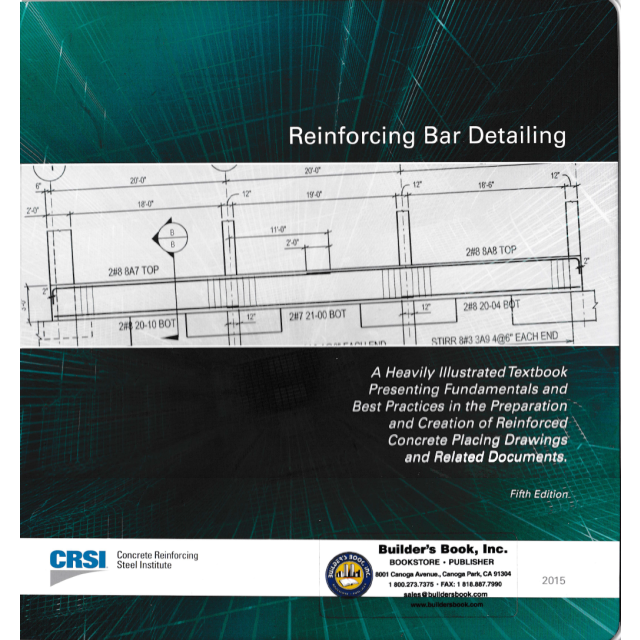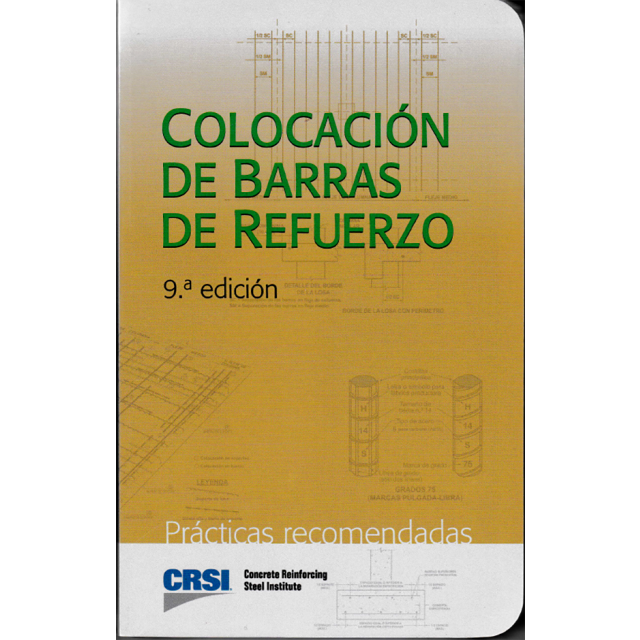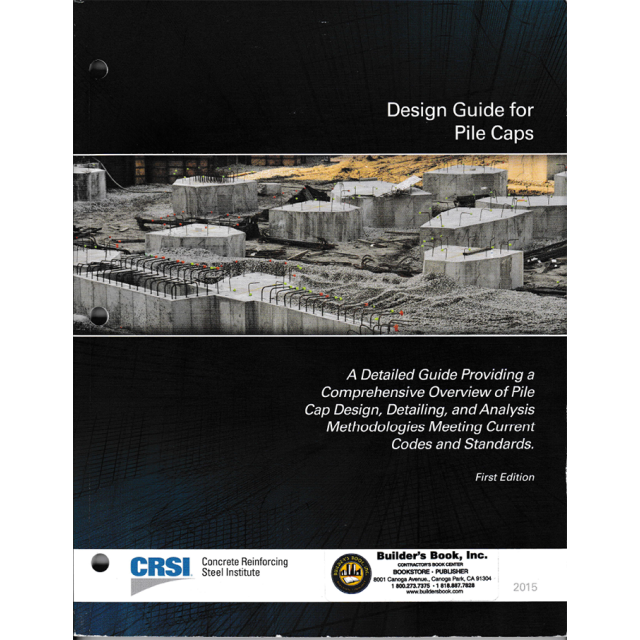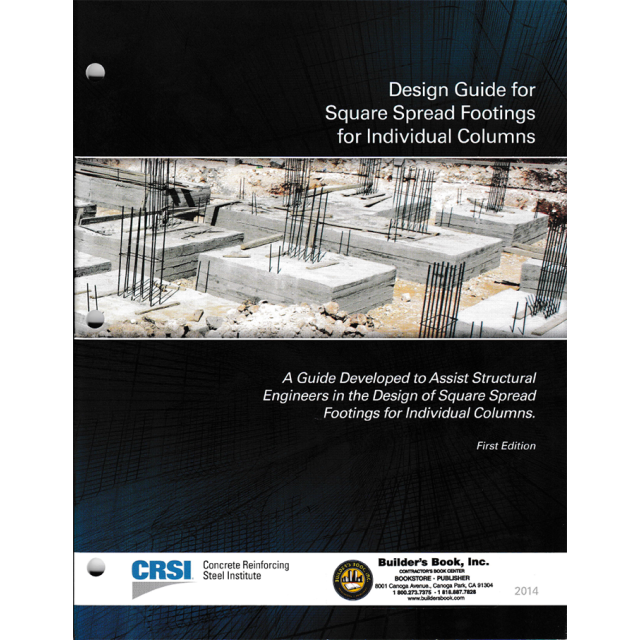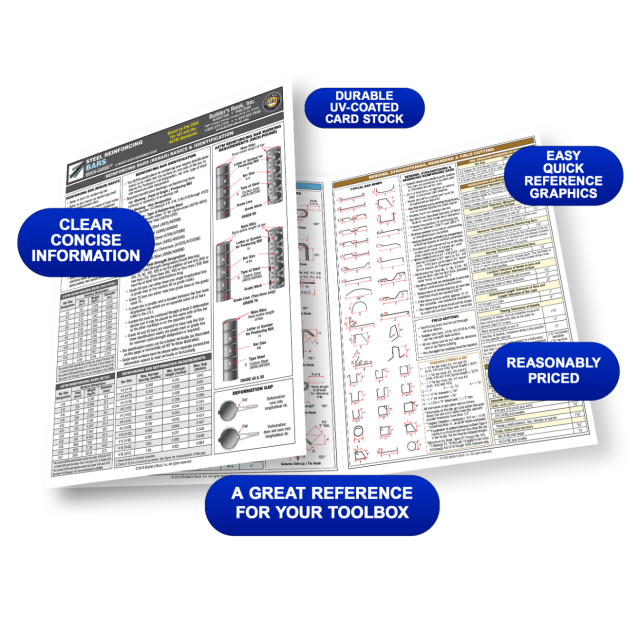Manual of Standard Practice 29th Edition CRSI (3 Copies Left)
Manual of Standard Practice 29th Edition
Soft Cover Book
192 pp.; 29th Edition
NOTE: First printing errata available by clicking here.
The29th Edition of the Manual of Standard Practice containsinformation on recommended industry practices for estimating, detailing,fabricating, and placing reinforcing steel for reinforced concreteconstruction. Includes suggested specifications for reinforcing steel.
Newmaterial includes:
§ Expanded coverage of all 4 types ofreinforcing bars
§ Coverage of new bar size #20 where possible
§ Updated and expanded markings for all Gradesof reinforcing bars produced in the U.S.
§ Reformat of Chapter 3, Bar Supports, to serveas a Commentary to ANSI/CRSI RB4.1,
Standard for Supports for Reinforcement used in Concrete
§ Expanded “first bar placement” illustrationsfor various types of reinforced concrete members
§ Doubled number of Typical Bend Shapes andadded coverage of Typical Measuring Points for reinforcing bar fabrication
§ Added coverage of voided concrete slabconstruction
§ New Chapters on Highways and Bridges andSustainability in Reinforced Concrete
TABLE OF CONTENTS
CHAPTER 1
MaterialSpecifications for Reinforcing Bars
1.1 Introduction
1.2 Reinforcing Bars
1.3 ACI 318 Code—Requirements for Reinforcing Bars
1.4 Specialty Reinforcing Bars
1.5 Spiral Reinforcement
1.6 Welding of Reinforcing Bars
1.7 Identification Marks
CHAPTER 2
Welded Wire Reinforcement (WWR)
2.1 Introduction
2.2 ASTM Specifications
2.3 WWR Style Identification
2.4 Specifying Welded Wire Reinforcement
2.5 Detailing Welded Wire Reinforcement
2.6 ASTM Specification for Epoxy-Coated Wire and Welded Wire Reinforcement
2.7 ASTM Specification for Zinc-Coated (Galvanized) Steel Welded WireReinforcement
2.8 ASTM Specification for Stainless-Steel Steel Welded Wire Reinforcement
2.9 Rust
2.10 Handling, Shipping and Unloading
CHAPTER 3
Supports for Reinforcement (Bar Supports)
3.1 Introduction
3.2 Side-Form Spacers
3.3 Recommendations for Bar Supports
3.4 Placing Reinforcing Bars
3.5 One-Way Solid Slabs
3.6 Joists
3.7 Beams and Girders
3.8 Sequence of Placing Bar Supports and Reinforcing Bars in Two-Way Flat Plate
3.9 Sequence of Placing Bar Supports and Reinforcing Bars in Two-Way Flat Slab
3.10 Sequence of Placing Bar Supports and Reinforcing Bars in Two-Way WaffleSlab
3.11 Bar Supports for Special Conditions
3.12 Bar Supports for Highway Bridge Slab Reinforcement
CHAPTER 4
Notes and Recommendations to the Architect/Engineer
4.1 Introduction
4.2 Recommended Industry Practice
4.3 Sizes of Reinforcing Bar and Spirals
4.4 Grade or Minimum Yield Strength Designation
4.5 Standard Notation
4.6 Project Drawings
4.7 Length of Reinforcing Bars
4.8 Beams and Girders
4.9 Joist Construction
4.10 Flat Plates and Flat Slabs
4.11 Post-Tensioned Beams and Slabs
4.12 Falsework and Form Reuse
4.13 Columns
4.14 Structural Integrity
4.15 Splices
4.16 Designing with Specialty Reinforcing Bars
4.17 Fabrication of Reinforcing Bars
4.18 Placing Drawings
4.19 Special Services and Items
4.20 Field Cutting of Reinforcing Bars
Suggested Specifications for Reinforcing Steel
CHAPTER 5
Recommended Industry Practice for Estimating Reinforcing Materials andServices
5.1 Introduction
5.2 Scope
5.3 General
5.4 Fabrication
5.5 Extras
5.6 Radial Prefabrication (Bend type 109)
5.7 Standard Hooks
5.8 Splicing of Bars
5.9 Bar Dimensions, Extensions and Cut-Offs
5.10 Spacers for Spiral Reinforcement
5.11 Temperature-Shrinkage Reinforcement
5.12 Slabs, Walls, Mats, or Footings Bar Spacing
5.13 Joists Adjoining Beams or Walls
5.14 Corner Bars
5.15 Bar Supports
5.16 Side-Form Spacers
5.17 Welded Plain or Deformed Wire Reinforcement
5.18 Post-Tensioned Construction
5.19 Placing Facilitation
CHAPTER 6
Recommended Industry Practice for Detailing Concrete Reinforcing Steel
6.1 Introduction
6.2 Technical Service by Seller
6.3 Detailer Responsibilities
6.4 Placing Drawings
6.5 Miscellaneous Detailing Practices
6.6 Detailing for Specialty Reinforcing Bars
6.7 3D Modeling and BIM
CHAPTER 7
Recommended Industry Practices for Fabrication of Concrete Reinforcing Steel
7.1 Introduction
7.2 Typical Bend Shapes
7.3 Guidelines for Typical Bend Shapes
7.4 Bend Diameters
7.5 Typical Measuring Points
7.6 Typical Fabricating Tolerances
7.7 Bend Curvature Tolerances
7.8 Special Bend Shapes
7.9 Bending
7.10 Quality and Inspection
7.11 Typical Bundling and Tagging
7.12 Special Bungling and Tagging
7.13 Typical Fabrication
7.14 Special Fabrication
7.15 Radial Prefabrication (Bend Type 109)
7.16 Round Spirals (Bend Types 400 and 405)
7.17 Shipment Considerations
7.18 Extra Work or Materials
7.19 Special Services
7.20 Special Items
7.21 Fabrication for Specialty Reinforcing Bars
CHAPTER 8
Recommended Industry Practice for Placing Reinforcing Bars
8.1 Introduction
8.2 Fusion Welding of Reinforcing Bars
8.3 Surface Condition of Reinforcing Bars
8.4 Field Re-alignment of Reinforcing Bars
8.5 Spacing of Reinforcing Bars
8.6 Splices in Reinforcing Bars
8.7 Embedment and Extensions
8.8 Tolerances in Placement
8.9 Supports for Reinforcement (Bar Supports)
8.10 Concrete Protection for Reinforcing Bars
8.11 Field Cutting of Reinforcing Bars
8.12 Handling and Storage
8.13 Tying
8.14 Field Bending
CHAPTER 9
Recommended Industry Practice for Contract Components
9.1 Preface
9.2 Material Supply Contract
9.3 Material Supply and Installation Contract
CHAPTER 10
Notes on Concrete Joist and Voided Concrete Slab Construction
10.1 Concrete Joist Construction
10.2 Voided Concrete Slab Construction
CHAPTER 11
Highways and Bridges
11.1 Introduction
11.2 Corrosion Protection of the Reinforcement
11.3 Bridge Decks
11.4 Location and Types of Bar Supports for Bridge Decks
11.5 Bridge Railings, Sidewalks, Barrier Walls, and Medians
11.6 Bridge Approach Slabs
11.7 Bridge Abutments
11.8 Bridge Bents
11.9 Retaining Walls
11.10 Sound Walls
11.11 Sign and Light Pole Foundations
11.12 Drainage Structures
11.13 Pavements
CHAPTER 12
Sustainability in Reinforced Concrete
8.1 Introduction
8.2 Definition
8.3 Keys to Reinforced Concrete Sustainability
8.4 Industry Position
8.5 Product Category Rules and Environmental Product Declaration
APPENDIX A
U.S. Manufacturers of Concrete Reinforcing Bars
APPENDIX B
Legacy Bar Bends
APPENDIX C
Notes on Metrication
APPENDIX D
References
GLOSSARY
INDEX
Productcode: 10-MSP-2018
| Price | $142.95 |
|---|---|
| Customer Service | Customer ServiceWe're Here To Help Call us anytime during our customer service hours... Monday through Friday - 8:30 am to 4:30 pm (Pacific) Order Questions: TOLL FREE, 800-273-7375 (Outside the U.S. call 818-887-7828). Our Address: 8001 Canoga Avenue Canoga Park, CA 91304 US Phone: 800-275-2665 E-mail: sales@buildersbook.com
|
| Description | Manual of Standard Practice 29th Edition Soft Cover Book NOTE: First printing errata available by clicking here. The29th Edition of the Manual of Standard Practice containsinformation on recommended industry practices for estimating, detailing,fabricating, and placing reinforcing steel for reinforced concreteconstruction. Includes suggested specifications for reinforcing steel. Newmaterial includes: § Expanded coverage of all 4 types ofreinforcing bars § Coverage of new bar size #20 where possible § Updated and expanded markings for all Gradesof reinforcing bars produced in the U.S. § Reformat of Chapter 3, Bar Supports, to serveas a Commentary to ANSI/CRSI RB4.1, § Expanded “first bar placement” illustrationsfor various types of reinforced concrete members § Doubled number of Typical Bend Shapes andadded coverage of Typical Measuring Points for reinforcing bar fabrication § Added coverage of voided concrete slabconstruction § New Chapters on Highways and Bridges andSustainability in Reinforced Concrete TABLE OF CONTENTS CHAPTER 1 CHAPTER 2 CHAPTER 3 CHAPTER 4 CHAPTER 5 CHAPTER 6 CHAPTER 7 CHAPTER 8 CHAPTER 9 CHAPTER 10 CHAPTER 11 CHAPTER 12 APPENDIX A APPENDIX B APPENDIX C APPENDIX D GLOSSARY INDEX Productcode: 10-MSP-2018 |

